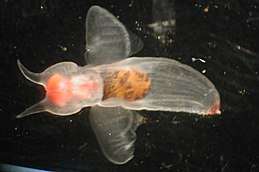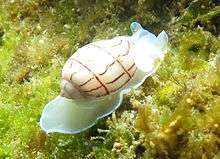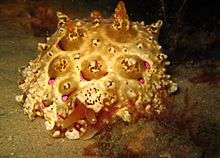Opisthobranchia
Opisthobranchs (/əˈpɪsθəˌbræŋks, -θoʊ-/[2]) is now an informal name for a large and diverse group of specialized complex gastropods which used to be united in the subclass Opisthobranchia. That taxon is no longer considered to represent a monophyletic grouping.[3]
| Opisthobranchia | |
|---|---|
 | |
| Notodoris minor | |
| Scientific classification | |
| Kingdom: | |
| Phylum: | |
| Class: | |
| (unranked): | clade Heterobranchia informal group "Opisthobranchia" Milne-Edwards, 1848 |
| Included groups | |
|
clade Cephalaspidea | |
Euopisthobranchia is a taxon containing a revised collection of opisthobranchs, and that taxon is considered monophyletic. Euopisthobranchia does not include some "traditional" opisthobranchs such as the Sacoglossa and the Acochlidiacea.[4] The subclass Heterobranchia now contains all the species which used to be assigned to Opisthobranchia, plus all the species in the Pulmonata.
The subclass Opisthobranchia included species in the order Cephalaspidea (bubble shells and headshield slugs), the sacoglossans, anaspidean sea hares, pelagic sea angels, sea butterflies, and many families of the Nudibranchia.[3]
Opisthobranch means "gills behind" (and to the right) of the heart. In contrast, Prosobranch means gills in front (of the heart). Opisthobranchs are characterized by two pairs of tentacles and a single gill behind and to the right of the heart. Opisthobranchia are known from as early as the Carboniferous.[5]
Taxonomy
Under the 1931 classification system drawn up by Johannes Thiele, the class Gastropoda was divided into three subclasses; Prosobranchia, Pulmonata and Opisthobranchia. The latter two were later combined into a single order.[6]
The current classification of the gastropods is more nuanced, with the following subclasses:[7]
- Subclass Caenogastropoda
- Subclass Cocculiniformia
- Subclass Heterobranchia
- Subclass Neomphalina
- Subclass Neritimorpha
- Subclass Patellogastropoda
- Subclass Vetigastropoda
- Subclass Gastropoda incertae sedis
As a non-monophyletic taxon
.jpg)
It was speculated as far back as 1985 that the Opisthobranchia were paraphyletic, based on morphological evidence, and had given rise to the Pulmonata, a group also of subclass rank.[8]
Because the Pulmonata are a sibling group to an opisthobranch taxon, some authors argued that the Opisthobranchia are therefore not a monophyletic group and can no longer be accepted as a valid taxon. The opisthobranchs are now included within the subclass Heterobranchia, although many manuals and websites still use the old classification.
A phylogenetic study published in November 2004,[9] gave new definitions of the seven main lineages of the Opisthobranchia.
However, in 2005, a study of rRNA gene sequences could not resolve monophyly versus paraphyly of the Opisthobranchia [10] Subsequent taxonomic classification in 2005 overturned the Opisthobranchia as a valid clade, reclassifying it as an informal group within the Heterobranchia.[3] Accordingly, articles no longer use the term Opisthobranchia, replacing it with Heterobranchia to emphasise a different concept.[4] By 2011, the "Opisthobranchia" were declared artificial and obsolete and were replaced by new phylogenetic hypotheses.[11]
Linnean taxonomy
Order Opisthobranchia Milne-Edwards, 1848 - sea slugs
- Suborder Cephalaspidea P. Fischer, 1883 - headshield slugs and bubble shells
- Suborder Sacoglossa von Ihering, 1876 - sap-sucking slugs and bivalved gastropods
- Suborder Aplysiomorpha P. Fischer, 1883 - sea hares
- Suborder Notaspidea P. Fischer, 1883 - sidegill slugs
- Suborder Thecosomata Blainville, 1824 sea butterflies with shells
- Suborder Gymnosomata Blainville, 1824 - sea angels, no shells
- Suborder Nudibranchia Blainville, 1814 - nudibranchs
- Infraorder Anthobranchia Férussac, 1819
- Infraorder Cladobranchia Willan & Morton, 1984
Description
The reduction or loss of the shell, the elaboration of the head, foot or mantle, and the acquisition of chemical defences are evolutionary trends shared by most opisthobranch taxa.[12]
Opisthobranchs have undergone detorsion, an evolutionary reversal of the half revolution torsion of their immediate ancestors. As a result of this detorsion, the visceral ganglia no longer overlap and are described as euthyneurous (as opposed to streptoneurous, the more common condition among gastropods, in which these ganglia form a distinct twist within the animal's body).
There is no marked distinction between head and mantle. The tentacles, situated close to the mouth, are used for orientation. Behind them are the rhinophores, olfactory organs which often have complex forms. The middle part of the foot is the sole, used for locomotion. The sides of the foot have evolved into parapodia, fleshy winglike outgrowths. In several suborders, such as the Thecosomata and Gymnosomata, these parapodia are used to move in a swimming motion.
Their eyes are simple pit-cup eyes with a lens and cornea capable of detecting light and the passage of shadows but not of producing a coherent image.[13]
Ecology
Opisthobranchia represents a morphologically diverse group of gastropods occupying a great variety of ecological niches. Opisthobranchs have a global distribution, but are restricted almost exclusively to marine habitats with the only exception being few freshwater acochlidians.[12]
Defense
Principally soft-bodied marine creatures with a reduced or absent shell and no operculum, opisthobranchs use other methods for protection. Due to a combination of outstanding camouflage and aggressive toxicity they have few predators. However, some use warning colouration. Animals that do predate opisthobranchs include other opisthobranchs and toxin-resistant predators like sea spiders.
Opisthobranchs secrete irritants such as strong acids or accumulate toxins from their food. Aeolidioidea pirate the stinging cells from their cnidarian prey and use them for their own defense.[14][15]
Diet
Opisthobranchs may be herbivores, detritivores or carnivores. Being slow, the carnivores hunt sedentary prey. They may eat bryozoans, Cnidaria, or sponges, absorbing the sponge toxin for defensive purposes. Opisthobranchs may maintain the zooxanthellae of their coral prey and use their metabolic products for themselves. Some herbivorous slugs do the same with the chloroplasts of the algae they eat.[16]
Communication
Like most lifeforms, they use chemical cues for much of their life cycle. The planktonic larvae float until a pheromone alerts them to a suitable settling site, sometimes delaying metamorphosis until favourable chemicals, such as prey pheromones, are detected. Some mating opisthobranchs release chemicals to attract conspecifics.
Reproduction

Opisthobranchs are hermaphrodites and have complex reproductive strategies, typically involving reciprocal sperm transfer and storage until the eggs are ready for fertilisation.[17] Eggs are commonly laid in ribbons of varying structure. The egg ribbons are usually unique to each species and in some cases are the only means of differentiating them.[18]
See also
References
This article incorporates CC-BY-2.0 text from reference[12]
- Jensen, K. R. (1997). "Evolution of the Sacoglossa (Mollusca, Opisthobranchia) and the ecological associations with their food plants". Evolutionary Ecology. 11 (3): 301–335. doi:10.1023/A:1018468420368.
- "Opisthobranch". Oxford Dictionaries UK Dictionary. Oxford University Press. Retrieved 21 January 2016.
- Bouchet, Philippe; Rocroi, Jean-Pierre; Frýda, Jiri; Hausdorf, Bernard; Ponder, Winston; Valdés, Ángel & Warén, Anders (2005). "Classification and nomenclator of gastropod families". Malacologia. Hackenheim, Germany: ConchBooks. 47 (1–2): 1–397. ISBN 3-925919-72-4. ISSN 0076-2997.
- Jörger, K. M.; Stöger, I.; Kano, Y.; Fukuda, H.; Knebelsberger, T.; Schrödl, M. (2010). "On the origin of Acochlidia and other enigmatic euthyneuran gastropods, with implications for the systematics of Heterobranchia". BMC Evolutionary Biology. 10: 323. doi:10.1186/1471-2148-10-323. PMC 3087543. PMID 20973994.
- (in Czech) Pek I., Vašíček Z., Roček Z., Hajn. V. & Mikuláš R.: Základy zoopaleontologie. - Olomouc, 1996. 264 pp., ISBN 80-7067-599-3.
- Knudsen, B.; Kohn, B.; Nahir, B.; Mcfadden, S.; Moroz, L. (February 2006). "Complete DNA sequence of the mitochondrial genome of the sea-slug, Aplysia californica: conservation of the gene order in Euthyneura". Molecular Phylogenetics and Evolution. 38 (2): 459–469. doi:10.1016/j.ympev.2005.08.017. ISSN 1055-7903. PMID 16230032.
- Gofas, S. (2014). Gastropoda. Accessed through: World Register of Marine Species at http://www.marinespecies.org/aphia.php?p=taxdetails&id=101 on 2015-02-12
- Haszprunar G. (1985). "The Heterobranchia – a new concept of the phylogeny of the higher Gastropoda". Zeitschrift für zoologische Systematik und Evolutionsforschung. 23 (1): 15–37.
- Cristina Grandea; Josè Templadoa; J. Lucas Cerverab; Rafael Zardoya (2004). "Phylogenetic relationships among Opisthobranchia (Mollusca: Gastropoda) based on mitochondrial cox 1, trnV, and rrnL genes". Molecular Phylogenetics and Evolution. 33 (2): 378–388. doi:10.1016/j.ympev.2004.06.008. PMID 15336672.
- Verena Vonnemann; Michael Schrödl; Annette Klussmann-Kolb; Heike Wägele (2005). "Reconstruction of the phylogeny of the Opisthobranchia (Mollusca: Gastropoda) by means of 18s and 28s rRNA gene sequences". Journal of Molluscan Studies. 71 (2): 113–125. doi:10.1093/mollus/eyi014.
- Schrödl M; Jörger KM; Klussmann-Kolb A; Wilson NG. "Bye bye "Opisthobranchia"! A review on the contribution of mesopsammic sea slugs to euthyneuran systematics" (PDF). Thalassas. 27 (2): 101–112.
- Kristof, Alen; Klussmann-Kolb, Annette (2010). "Neuromuscular development of Aeolidiella stephanieae Valdez, 2005 (Mollusca, Gastropoda, Nudibranchia)". Frontiers in Zoology. 7 (1): 5. doi:10.1186/1742-9994-7-5. PMC 2822759. PMID 20205753.
- Hughes, H. P. I. (1970). "A light and electron microscope study of some opisthobranch eyes". Zeitschrift für Zellforschung und Mikroskopische Anatomie. 106: 79–98. doi:10.1007/BF01027719.
- Gosliner, Terrence (1987) Nudibranchs of Southern Africa p.7 ISBN 0-930118-13-8
- Heike Wägele; Annette Klussmann-Kolb (2005). "Opisthobranchia (Mollusca, Gastropoda) – more than just slimy slugs. Shell reduction and its implications on defence and foraging". Frontiers in Zoology. 2 (3): 3. doi:10.1186/1742-9994-2-3. PMC 554092. PMID 15715915.
- Gosliner, Terrence (1987) Nudibranchs of Southern Africa p.9 ISBN 0-930118-13-8
- Debelius, Helmut (2001) Nudibranchs and Sea Snails Indo-Pacific Field Guide p.7 Ikan, Frankfurt
- Gosliner, Terrence (1987) Nudibranchs of Southern Africa p.11 ISBN 0-930118-13-8
Further reading
- Bieler R. (1990). "Haszprunar's "clado-evolutionary" classification of the Gastropoda—a critique". Malacologia 31(2): 371–380, 2 tabs. [28 May; G, Haszprunar's response published in Malacologia, 1990, 32(1): 195–202].
- Bieler R. (1992). "Gastropod phylogeny and systematics". Annual Review of Ecology and Systematics. 23: 311–338. doi:10.1146/annurev.es.23.110192.001523.
External links
| Wikimedia Commons has media related to Opisthobranchia. |
| Wikispecies has information related to Opisthobranchia |
- The Sea Slug Forum, a resource from the Australian Museum.
- Sea slugs of Hawaii
- Born to be Wild: Sea Slugs, retrieved 30.4.2008
- Various opisthobranch species from Indonesia, Philippines and Thailand
- Nudi Pixel Nudi Pixel is a web-based identification tool for opisthobranchs worldwide


